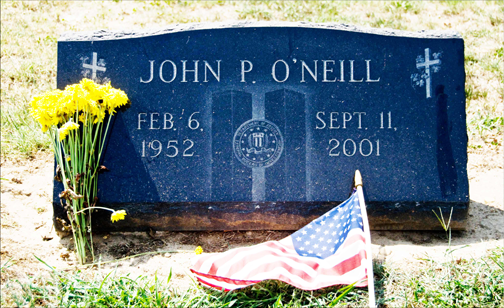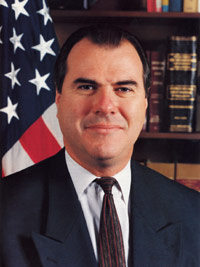“The Man Who Warned America” By Murray Weiss

Gravestone of former FBI Agent John O'Neill in Holy Cross Cemetery, Mays Landing, NJ | photo © Katharine Gilbert
By Sabina Clarke
In this riveting biography of former FBI agent John O’Neill, the nation’s top counterterrorism cop in both Washington, D.C. and later New York City, author Murray Weiss offers an accurate and factual account of O’Neill’s spectacular career and his complex clandestine personal life.
O’Neill was a charismatic, larger than life figure who didn’t fit the mold of the traditional FBI agent. He was cut from a different cloth, dressing in Burberry suits and Bruno Magli shoes; entertaining foreign dignitaries lavishly, often at his own expense.
O’Neill was a bon vivant who mingled with the clubby crowd at Elaine’s, one of the trendy New York night spots he frequented yet he was also a tireless investigator who worked through the night.
Surprisingly, not too many Americans know who John O’Neill is or even what his connection is to events leading up to 9/11. It was John O’Neill who led the investigations of the bombings of the World Trade Center in 1993, a US base in Saudi Arabia in 1996, the U.S. embassies in Nairobi and Dar-Es-Salaam in 1998 and the U.S.S. Cole naval ship in 2000. Yet, this unsung American hero was thwarted at every step of the way by both the Clinton and later the Bush administrations.
Dating back to 1995, O’Neill had warned his supervisors at the Bureau that Osama Bin Laden was the greatest threat to our national security; impressing upon them that Bin Laden and other Islamic fundamentalist radicals had the capacity to strike on American soil. But it appears the government wasn’t listening or had a very different agenda. Also, there was that special relationship the Bush dynasty had with the Bin Ladens going back to the presidency of George Herbert Walker Bush.
O’Neill complained bitterly that the U.S. State Department and the oil lobby who made up former President George W. Bush’s entourage, blocked attempts to prove Bin Laden’s guilt. He met on several occasions with French journalists Jean-Charles Brisard and Guillaume Dasquie, the authors of the explosive book Hidden Truth (released in 2001 and virtually ignored by the U.S. media) and confided to them that the main obstacles to investigating Islamic terrorism were U.S. corporate oil interests.
And, precisely because of his activism and relentless search for the truth, it can be surmised that O’Neill became the government’s chief target; he was quickly becoming the man who knew too much.
In June 1998, when he let a girlfriend use a bathroom in a secret FBI garage after his car broke down, he was suspended by the Department for 15 days and passed over for a promotion to deputy director of the national security division at FBI headquarters because of what the Bureau referred to as the “car incident”. Then in May 2000, he was once again passed over to head the FBI’s New York Office—a job he both coveted and deserved.
Another minor infraction by O’Neill in July 2000 prompted an FBI internal probe when his briefcase containing classified information was missing at an FBI retirement seminar in Florida. Although, it was quickly recovered with no documents missing, this breach like the first one was exploited and exaggerated by the Department—putting another blemish on O’Neill’s otherwise stellar career.
Yet despite these so called “breaches,” soon after the bombing of the U.S.S. Cole on October 12, 2000, O’Neill was sent to Yemen to head the U.S. investigation team and almost immediately was confronted by Barbara Bodine, the U.S. ambassador to Yemen who later refused to allow him to return to Yemen—making him the first FBI official ever denied ‘country clearance’ by a State Department official. The FBI brass, it could be conjectured, may have been under orders from above since they did not back O’Neill up— a somewhat unusual stand.
By then, O’Neill was becoming increasingly disenchanted with the obstacles he faced daily investigating global terrorism. For the first time, he contemplated retiring from the job he loved. He went public with charges of being stymied by the Bush administration and retired from the FBI on August 22nd, 2001 just three days before the New York Times published a story stating the FBI was investigating John O’Neill’s “briefcase incident.” A press release was most likely sent out by the Bureau to further embarrass and discredit him. On the last day of his 31 year career with the FBI, John O’Neill signed the order for the FBI to return to Yemen to continue the investigation of the bombing of the USS Cole.
His first day as Director of Security at the World Trade Center was September 11, 2001 –the day the Twin Towers fell.
Reviewer’s Note: The circumstances surrounding O’Neill’s death on September 11th, 2001 are suspicious. The official version is that he that he survived the impact of the first plane but was killed on his way to Building # 2 when it was struck by a plane or brought down by explosives — the latter being the more likely scenario given the new information now available. Then, reportedly, he made a phone call to FBI headquarters and the last person to see him alive that day was an FBI agent named Wesley Wong.
Consider how convenient it would be for the government’s chief critic and chief defender to die in 9/11. If he had lived, John O’Neill would have gotten to the bottom of it all. That you can count on.

